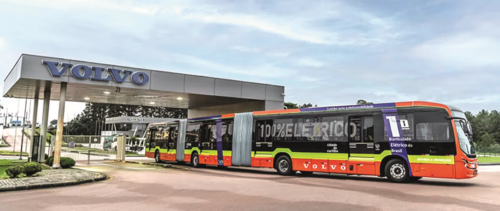
BRAZIL
Following the launch of its new BZR electromobility platform in March, Volvo’s first electric bi-artic BZR-based bus is being put through trials in Latin America. The bus rapid transit (BRT)-style bus will operate first in the city of Curitiba in Brazil, as well as in Bogotá in Colombia and in Mexico City. With a 28-metre body, the maximum capacity is up to 250 passengers, Volvo says.
“A BRT with these buses will be able to carry the same number of passengers as a subway system, but with infinitely lower implementation and operating costs, as well as zero emissions,” said President of Volvo Buses Latin America André Marques.
The bi-articulated electric buses are equipped with two 200kW electric motors, the equivalent of 540hp, and have a two-speed automated gearbox based on the Volvo I-Shift transmission.
Total charging time is stated as between two and four hours, with the option of installing a charger on the roof for quick charging at BRT terminals.
The concept of bi-articulated buses was introduced by Volvo Buses more than 30 years ago, as an evolution of the articulated bus. Since then, dozens of cities in Latin America have been using similar types of vehicles to transport large numbers of passengers. When it is launched for series production, the BZR bi-artic will be produced at Volvo’s industrial complex in Curitiba.
“With the validation of the electric version of our bi-articulated vehicle, we are strengthening our commitment to solutions for 100% safer, more efficient and sustainable transport for people,” concluded André.

